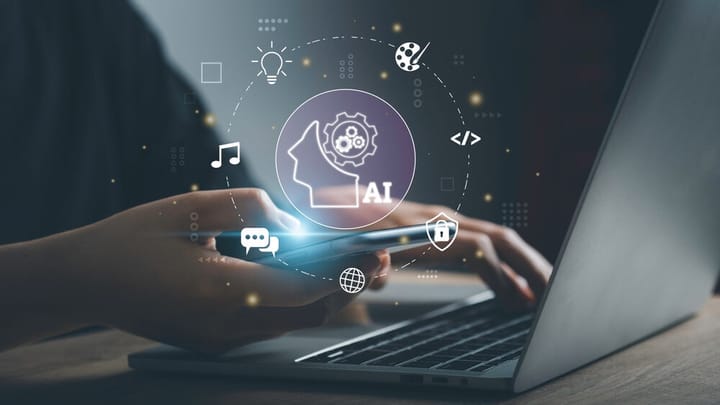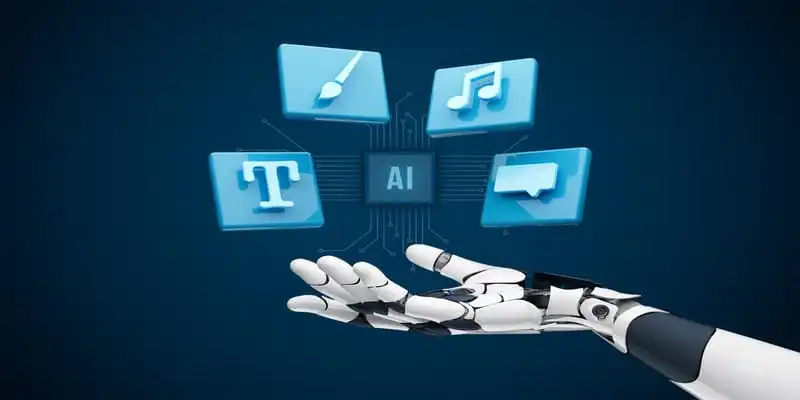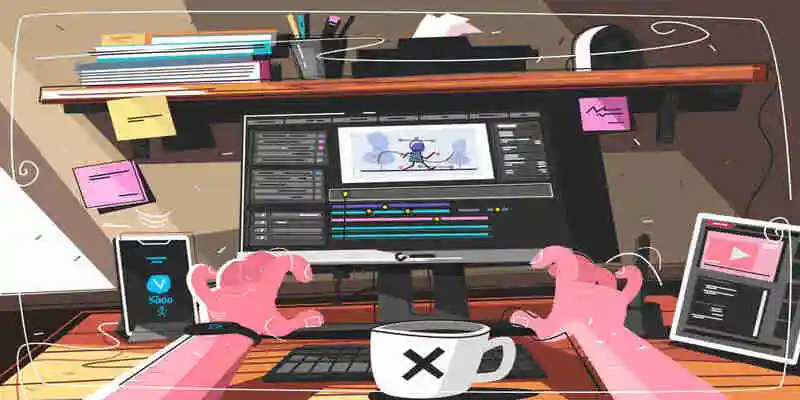AI in Arts is an Emerging Genre of Creativity
Computer creativity plays a significant role in revolutionizing creative activities like music, fine arts, architecture, and many more. Machines and computers are ambitious to support humans in developing creativity and taking it to the next level of excellence.
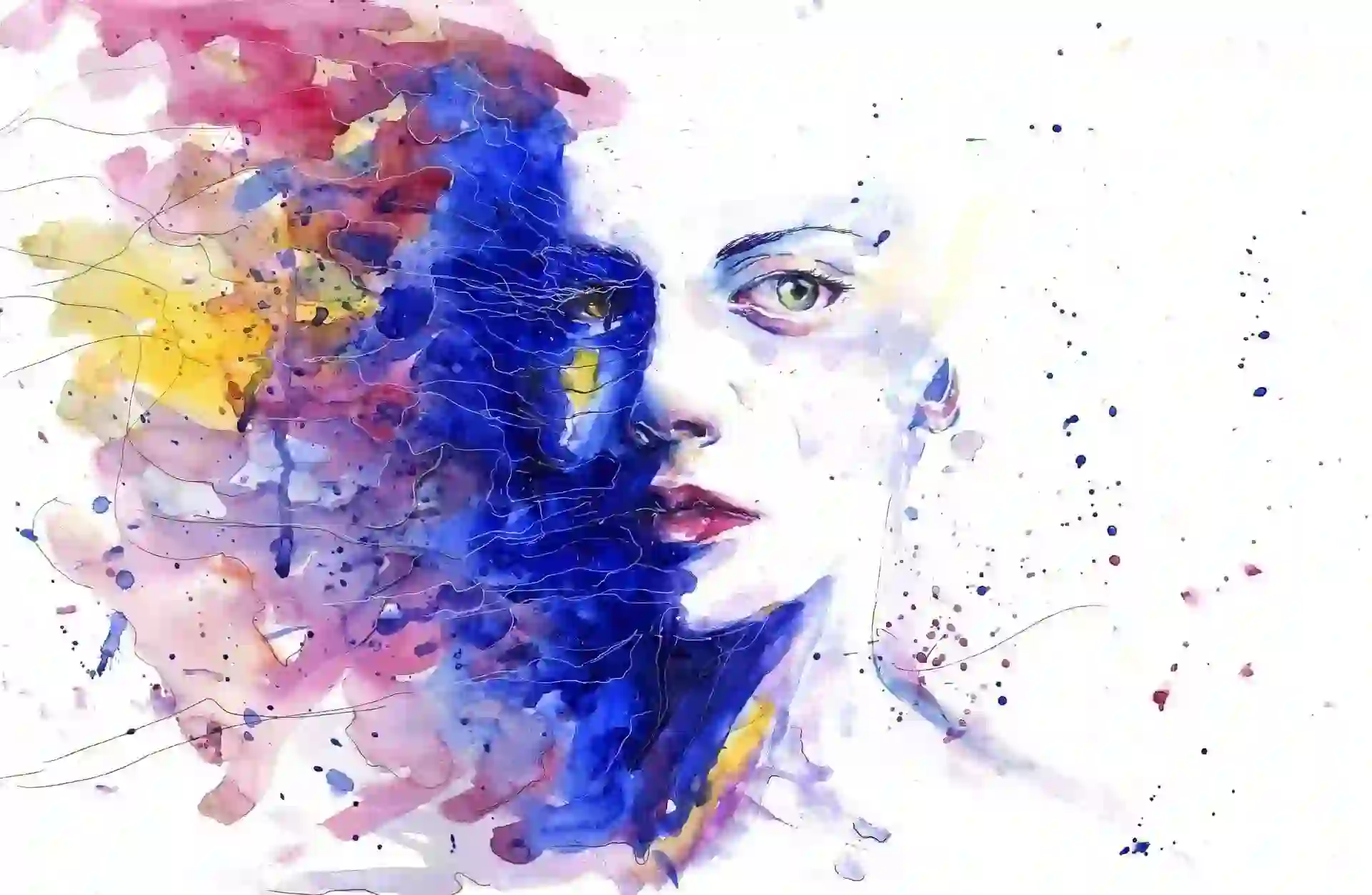
Artificial intelligence (AI) is one of the prominent technologies that are bringing far-reaching changes in the field of creativity. Computer creativity plays a significant role in revolutionizing creative activities like music, fine arts, architecture, and many more. Machines and computers are ambitious to support humans in developing creativity and taking it to the next level of excellence. These are tools helping creative humans, but they're a creative entity in the present and will lead humans in the future.
The global artwork market comprises of buyers and sellers dealing with various arts representing different cultures. The growth of online art-pieces sales is increased in the last few years and raised the market value to over $67 billion in 2018. Further, the volume of art sales also boosted from $39 million to $40 million in the same year.
Art is a powerful tool that assists humans to express their imaginary thoughts and emotions with the world. It offers a real opportunity to bring insightful understanding of feelings that's entertaining as well. It's not new to introduce computational methods with super-capabilities in Arts. Almost 150 years ago, Ada Byron shared her dream about a music composing machine. Artificial intelligence creating art is a fundamental approach in making machines and humans to function similarly. The query under-consideration is, can AI be able to create something like art?
The view of Computational Creativity possibly helps to achieve creativity of computer programs in replicating artistic behavior. Further, it's the study of building creative software to work like creative human minds. Such software is used to paint pictures, write poems, compose music, and invent mathematical theories. These innovative studies are based on studying human senses and producing software that works similarly.
The main fields of AI dealing with arts are image processing and audio processing for paintings and music. For image processing in art, the researchers develop algorithms by introducing machines with excess related images while in audio processing with related musical notes.
What are Art and Creativity?
The bond between Art and Creativity is defined by Oxford as:
“The expression or application of human creative skill and imagination, typically in a visual form such as painting or sculpture, producing works to be appreciated primarily for their beauty or emotional power”
Moreover, the concept of art and beauty covers under a philosophical branch called aesthetic. Oxford defines it as:
“A set of principles concerned with the nature and appreciation of beauty. The branch of philosophy which deals with questions of beauty and artistic taste”
It's clear now that machines should first thoroughly learn human behavior and minds to become artists like them. The main issue in creative intelligence arts is the absence of rules that control artistic behavior in humans. The most useful approach is to use a meta-heuristic algorithm to find a set of possible solutions in developing a sense of aesthetics.
Creativity is not beyond the scope of scientific study, but it must be investigated, harnessed, and used for the betterment of people. Creativity in Computational Art has become the discipline of age and caught up the attention of society. Before moving further, it must be embraced that computers cannot replicate humans completely. The operational and widely used definition of creativity is as follows:
“A creative idea is a novel and valuable combination of known ideas”
Creativity is a forward-thinking form of cracking problems related to memory, reasoning, and many others. Plus, it can regenerate laws, theories, and musical notes with a lovely unique touch that makes them different from their previous versions.
Top 5 features a machine should possess to be an AI artist
According to Penousal Machato, five creative intellects are involved in making an AI Artists:
Learning: The system should improve and adapt skill expressiveness according to new stimuli like humans.
Aesthetic Criteria: The system must be able to evaluate its created creativity and also can compare and rate its work like every human artist has his personal taste, liking, and disliking for a particular art.
Creativity: It can create novels and bring innovation with its unique designs similar to an outstanding artist. The system can also create a wholly unique art every time and not replace a few pieces in the art.
Sociability: Art should explain a particular social behavior, and AI should take it as a source of inspiration.
Equality: It must interact with humans like other beings at an equal level without any distinction.
At the moment, there is no system developed that's fulfilling all these five conditions to be exceptional.
Music records information in wave form; some old music players also have graphic visualizer showing musical notes. AI in music with voice processing can be made more accurate if the researcher also feed human response (liking, disliking, preferred wave formation, and view count,) in machines. It will resultantly produce lovable music in short time with more accuracy with deep learning technology.
Why are humans interested in creating art?
Humans are creative because of the following reasons psychologically:
- Artistic ability and intelligence
- Showing an emotional response
- Communicating with others
- Recalling past events
- Spreading knowledge
Art helps humans to explain something going in their minds, which is indescribable through words. Hence, it takes its viewer to the world of clarity showing the perspective of another person. In the past (over 30 to 40 thousand years back), humans didn't have time for self-introspection and spent their lives fighting, hunting, and staying safe. But with time, they found ways to get food with fewer struggles and reduced constant hunting. They got time to sat and watched their long shadows cast on walls by the fire. It was the first pause they considered more important than survival.
They started thinking about drawing; they used burned sticks to draw on them. They used their ancestor's cognitive abilities, like making and utilizing tools, forming language, developing memory, recognizing patterns, and developing expressions. These abilities developed during hunting helped them to survive and communicate with the world. The researchers are now trying to formulate the same capabilities in humans to support artificial art. Machines with memorizing, understanding language, learning, reasoning, expressing, and recognizing abilities are supposed to surpass humans.
Artwork Created by AI: The New Genre of Creativity
In the last decades, researchers made a significant struggle in creating AI Artists with complex algorithms. This complex information is creating stunning visuals, unique music, profound poetry, and transcendence movie scripts. An international team of scientists worked from the Massachusetts Institute of Technology (MIT) and the Center of Humans and Machines at the Max Plank Institute for Human Development. Their core findings suggested that humans perceive AI as an ingenious art creator, and they published their results in the journal iScience.
Many people are involved in creating arts via AI, including artists, curators, and programmers. Creative AI makes outstanding work of art autonomously and builds a connection between humans and AI.
What is Creativity in Art by AI?
AI-first gets enough information to create art by understanding and replicating the art. The specific technique is Style Transfer, which focuses on deep neural networks (DNNs) to reproduce, recreate, and mix unique artwork styles. AI involves identifying and combining stylistic patterns of one image and then merges it into the other. Here, the systems don't need coding experience or human artists. It applies to different art fields like paintings, music, video, photography; the rules are the same. The artists select their styles of interest they want to recreate and fed them into the algorithm. It then decides autonomously to develop a new art using previous information. Or, AI can also use a mixture of styles to generate mash-ups that are a blend of multiple classes.
Style transfer results are so stunning that these are indistinguishable from human artwork. For instance, vic8760, the Reddit user, mixed Napoleon's portrait and a High Renaissance painting to create a crowd scene. The given process can also be applied to generating unique music and video. Bach and math rock are clear examples that help AI replicate pieces as they are structured and consistently followed patterns.
Some style transfer tools allow their artists to control mashing-up patterns and decide what appears as the outcome. For instance, Google’s Project Magenta presents Beat Blender; it will enable artists to generate 2D palettes of drum beats. Moreover, one can draw paths via a space grid similar to Google AI's Style Transfer Grid for evolving new beats. The owner can then edit the four corners according to his wish with presets.
Another type of imitation is an image-to-image translation that’s similar to style transfer artificial creativity. It can change the apparent look of an image or video and allows the user to edit weather, season, or even time.
AI Doing the Job of Collaborator
Beyond imitation, there is the step of developing the relationship between AI and the artist.
Amper is a simple application of changing imitation to collaboration. The user can select instruments, styles, rhythms, and tempos from this online app to “collaboratively” generate new music.
Another example of AI generating new music is NSynth Super that helps musicians to work with it. The neural network involves understanding the sound's characteristics and then creating new tones by using original music's acoustic qualities. In this way, the musician will get a sound coming from different instruments at once. The musicians can use dials for exploring the source sound and then navigate new sounds. Its touch screen allows the user to drag fingers to comb the acoustic qualities of four basic sounds.
Mario Klingemann is known as Neurographer;he developed art-generating software by introducing photos, line drawings, and video in a code taken from machine learning research. His changes and manipulation in code resulted in his “Deteriorating Tech Meets Francis Bacon-Esque" abstracts and portraits.
Exciting Examples of AI Creating Art
1. PoemPortraits by Google
“Our transcendence adorns,
The society of the stars seems to be the secret"
Above two lines are not human-created but generated by a machine algorithm skilled on 20 million terms from old-poetry. However, the researchers trained algorithms via deep neural networks to memorize all the terms and make new combinations that make sense. PoemPortraits is Google's advanced art project that suggests and generates new poems according to the terms. It's another example of human collaboration with AI as humans feed words in their trained system according to their demand. Furthermore, it also allows its users to add selfie at the end of PeomPortrait. The project creator, Es Devlin, explains his strategy:
"It doesn't copy existing phrases but build a complex statistical model by uses its training material. Finally, the algorithm generates original phrases emulating the style of what it's been trained on"
However, the final generated poetry may have no meanings, but the most exciting fact about PoemPortraits is its collaborating ability. The AI system joins generated lines to make a new collective poem, and humans can review them after the generation of strings. All people who are working with algorithms worldwide finalize the perfect collaborative poem.
2. Robotic Painters
2.1. Unsecured Futures by Ai.Da:
Ai.Da first developed an ultra-realistic drawing robot with extraordinary abilities in 2019. She comes with creative painting features plus AI-powered algorithms for drawing, painting, and even sculpting. She uses pencil in her hand and an artificial eye to draw people. Its first exhibition was presented at Oxford University.
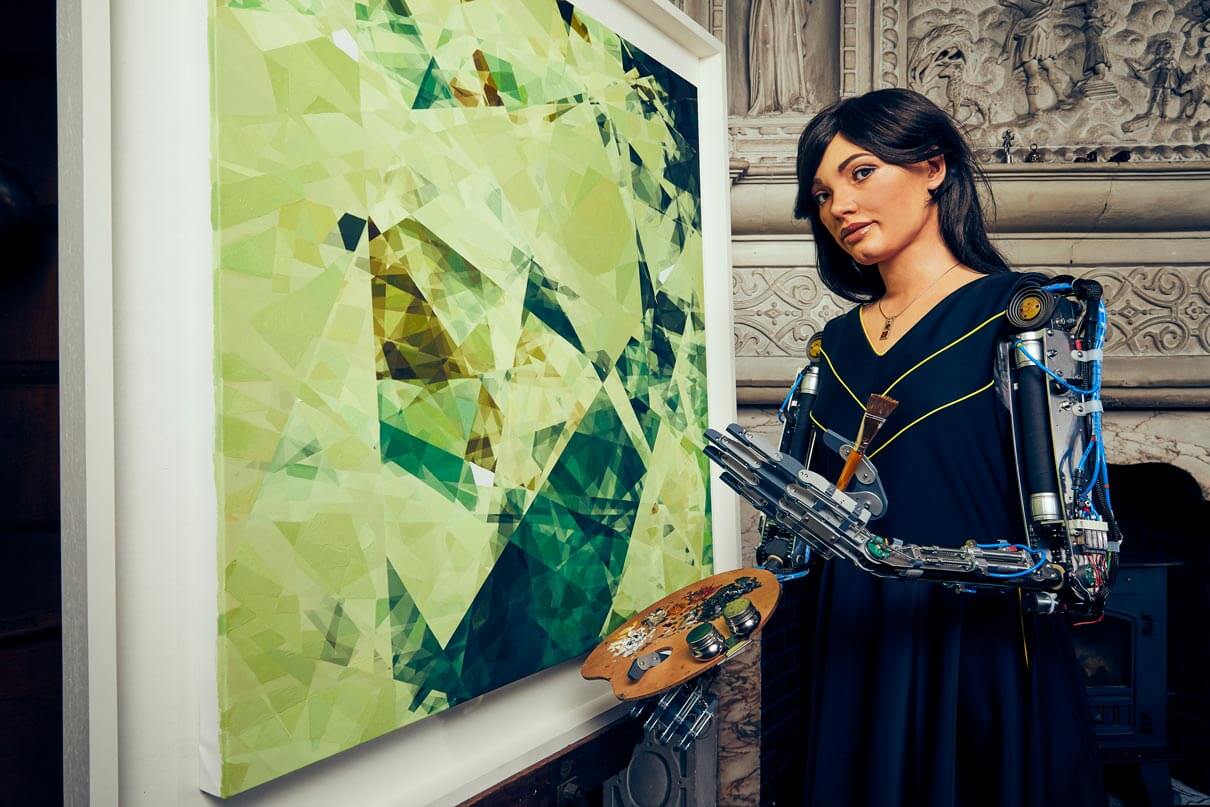
Ai.Da has no human-like feelings or emotions, but the developer of Ai.Da still claimed that it's the basis for vital discussions about evolving technologies. The creator of the display stated that:
"Humans are the most powerful and confident species on the planet, but how far do we want to take this power? To a Brave New World (Nightmare)? And if we use new technologies to enhance the power of few, we had better start safeguarding the future of the many"
2.2. The Robotic Action Painter
Leonal Moura developed RAP (Robotic Action Painter) that offers a creative intelligence system via stigmergy, randomness, and chromotaxis. Plus, it can determine the time required to compete for a specific painting.

2.3. Faceless Portraits Transcending Time: Meet AICAN
AICAN (Artificial Intelligence Creative Adversarial Network) is anAI Artist created by Ahmed Elgammal. The demonstration exhibited two sequence of canvas work at HG Commentary, including portraying dreamy faceless portraits.
The researchers introduced the system with 100,000 Western Art photos from previous five centuries and learned them with machine learning (ML). It then took information from its memory to create something excitingly new without human intervention.
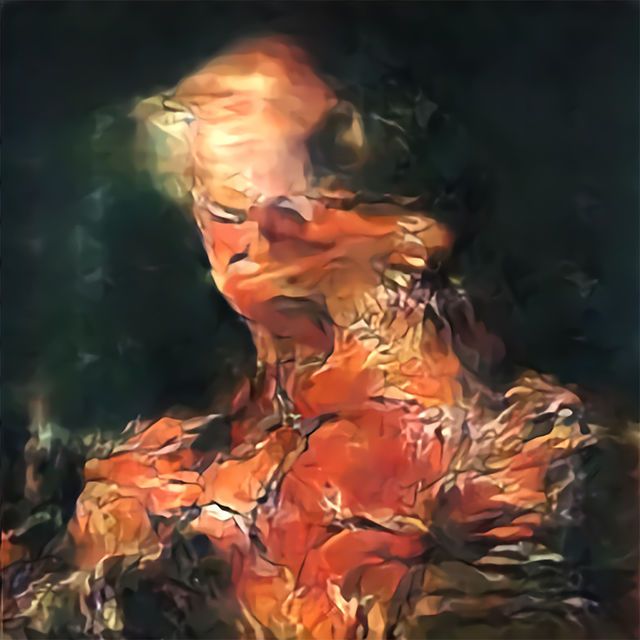
Again, it’s an example of effective collaboration between humans and machines. Art and Artificial Intelligence Laboratory works under its founder and director Ahmed at Rutgers University. Moreover, AICAN is not only a self-sufficient robot but also the right collaborator for human artists. People like AICAN's work genuinely, and 75% of them can’t distinguish its efforts from humans. One of its pieces is sold for $16,000 recently.
3. Music Composition and Analysis
Digital audio technology records, stores, manipulate, and reproduce music and audio processing made format—computers store music in the form of bits, storing information in binary data. Further, bit depths represent the number of bits involved in keeping audio signals. The strategy of storing music is dividing data into slices, and then each piece is treated as a binary code. To reserve this binary information, the musicians use discs or drives with the capacity of storing one or more terabytes (thousand of a gigabyte). The advanced voice processing in music depends on recording and data compressing digitally. The music availability as data files rather than as physical objects reduced distribution cost to a great extent. Here are some startups dealing with music composing and analysis by AI-trained machines.
3.1. Artificially Trained Network
The author trained Artificial Network with popular 992 musical fragments as an appealing criterium. The given system formed new aesthetically pleasing notes autonomously and got praise from many listeners.
3.2. Deep Artificial Composer
The researchers represented a recurrent note transition neural network model that can compose melodies automatically. This Deep Artificial Composer can produce songs following the training style, for instance, Irish and Klezmer music. The model generates extraordinary music sequences that are comparatively more novel than those created by humans.
3.3. Genesis by AIVA Technologies
An artificial platform, AIVA unites music and soundtracks for pictures, games, advertisements, and promos. It creates music with a wide range of emotions and mood swings to engage the particular audience to a greater extent. The AIVA music engine generates original scores in multiple ways, and all are indistinguishable from humans. The ways are:
- Uploading human-generated score and then temping music to base the process of composition.
- Use of algorithms to create music in different styles e.g., Middle Eastern or classical
The structure is currently under the use of the film industry and producers, but soon it will be available to every individual. It will allow them to generate music of their interest, changing mood, or taste at any time. Some music websites are also using recommendation algorithms that suggest the next piece according to the user's part.
3.4. Watson’s Emotional Insights
Alex Da Kid developed “heartbreak” as the concept of his “Not Easy” song by using Watson’s emotional insights. Alex wrote the song's foundation with X Ambassadors' collaboration and added other personal touches to finalize the track.
Moral Obligations in Art Work Generated by AI
DeepFake gets its name from its ability to create fake faces using deep learning algorithms. DeepFake keeps the character alive; that's why it can be used in the future to use the faces of dead actors in recent movies. Plus, it will attract more audiences and boost the film industry's revenues in the future.
But unfortunately, technology is also a threat for humans as anyone can create their faces artificially and associate an illegal activity with them. For instance, Bellie Eilish deepfake was created for pornographic content that hurt her and her fans.
Future Potential of AI in Arts
According to a concept proposed by Frieder Nake some 50 years ago, AI art could bring much less aesthetic innovation than critical innovation. AI art will be considered a medium of realist art under the assumption that it's the right agent in the real art world. Moreover, AI has the potential to self-criticize like humans in the real-world. It can also shape how to use technology in a new way, as Walter Benjamin mentioned in The Author as Producer. The future of AI in art is started already, but it takes time to cross human-like understanding. There is an excellent article written by Kyle McDonald to identify fake images generated by AI.
Plus, AI artists are no threat to humans, but it's an opportunity to push human creativity with lots of unique ideas. Collaboration between humans and machines is the most exciting artistic relationship.
Ending Words
One of the specific things that discriminates humans from other creatures is creating and enjoying art. Artificial intelligence illustration with artistic sense is supporting scientists to explore and understand the human brain operating system. The present systems using artificial intelligence as an artist do not follow the rigid rules and, in return, not offer outstanding results, but it still takes humans one-step more towards machines.
Time will decide if AI in the arts becomes a revolution, but it seems unlikely to happen from contemporary art history. However. It's a slow and steady process where machine learning in the art of intelligence exceeds skill by humans. Humans use technology like a telescope to enhance vision, smart-devices to connect, planes to fly, and many more. It is an example of using machines to better live as an extension of minds without threatening drawbacks. Similarly, devices are under use to boost creativity and to push artistic boundaries.
Cheers :)
